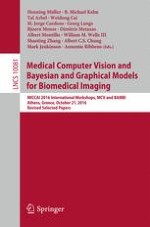2017 | Buch
Medical Computer Vision and Bayesian and Graphical Models for Biomedical Imaging
MICCAI 2016 International Workshops, MCV and BAMBI, Athens, Greece, October 21, 2016, Revised Selected Papers
herausgegeben von: Henning Müller, B. Michael Kelm, Tal Arbel, Weidong Cai, M. Jorge Cardoso, Georg Langs, Bjoern Menze, Dimitris Metaxas, Albert Montillo, William M. Wells III, Shaoting Zhang, Albert C.S. Chung, Mark Jenkinson, Annemie Ribbens
Verlag: Springer International Publishing
Buchreihe : Lecture Notes in Computer Science
